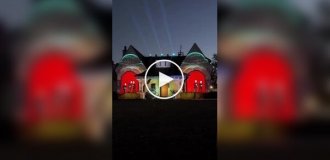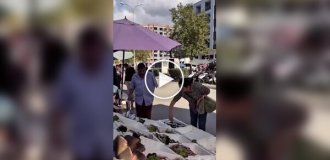Fort Boyard building (20 photos)
A little history: In 1666, Colbert, the French Minister of Finance under Louis XIV, created a shipyard for the construction of warships near the town of Rochefort, which is located at the mouth of the Charente River.

But the shipyard was vulnerable to attacks by enemy ships - it was not difficult to penetrate the mouth of the Charente, bypassing the guns of the coastal fortresses of the nearby islands. France fought a lot of wars at that time, and leaving this tasty morsel for the enemy without protection was madness. In addition, the main enemy of the French was England, which at that time owned the most powerful fleet.

Thus, the king and his entourage faced the problem of preserving the shipyard. Between two islands located near the mouth of the Charente - Aixom and Oleron - there was a sandbank called the Bayard spit. But, as you know, it is impossible to build a strong house on sand. What can we say about the fortress! However, the engineer Clairville, who was leading the work on strengthening Royom, made a proposal to build a similar fortress. Having become familiar with this proposal, Sebastian Le Prêtre de Vauban, a military engineer and marshal of France, expressed his opinion to the king:
“Sir, it is easier to grab the Moon with your teeth than to do such work in this place.” The construction project was not approved and was abandoned.
In 1763, at the end of the Seven Years' War (already during the reign of Louis XVI), the British managed to carry out two landings on the island of Aix, which once again clearly showed the vulnerability of the objects in this region. The question of building a fort was raised again, a project was developed, but it was also rejected as too expensive.

They returned to the project again in the next century, in 1801. In June of this year, a mixed commission of military and civilian builders proposed their design for the fortress. On February 7, 1803, the project was approved by the first consul of the state, Bonaparte.
Since the sandy base of the Bayar spit was not suitable for such construction, it was decided to make an embankment of stones. Work began in 1804. It is impossible to even imagine the complexity of this construction. Stone blocks extracted from local quarries were taken to the open sea and dumped on the fragile sandy bed of the spit. It was possible to carry out work only during low tide and only at those times of the year when the capricious nature of the coastal area allowed it to be done. In the third year of construction, it becomes clear that the heavy stone blocks, under their own weight, are sinking deeper and deeper into the sand.

Sisyphean labor - that’s how you can characterize this work. But not only that, the severe storms of the winter of 1807–1808, which caused a lot of trouble to the residents of the coast, destroyed the almost completed first two layers of the embankment. Nature's "ally" in the fight against the nascent fort is France's longtime enemies - the British. Their ships are constantly nearby, making an already almost hopeless undertaking simply insane.


Construction costs the state too much. Emperor Napoleon decides to reduce the originally planned size of the fort.
In 1809, work was resumed according to the newly approved project. But not even a year passes before construction is interrupted: this is facilitated by the destruction of Rochefort’s squadron by the British and numerous financial difficulties. 3.5 thousand cubic meters of stone were used to make the embankment, which cost the state treasury 3.5 million francs.
The project gained new life in 1840, under King Louis Philippe. The newly complicated relations with the British force military officials to puzzle over the eternal problem of protecting the Rochefort shipyard. By that time, the stone foundation had stabilized on its sandy bed and was no longer as fragile as at the beginning.
Technological progress made the work much easier: concrete, cement and hydraulic lime became available to builders. This eliminated the need to deliver heavy stones from the islands - from now on, blocks could be made right on the spot. The campaigns of 1847 and 1848 made it possible to find the necessary funds for construction costs.

Work on the foundation was completed in 1848, and by the end of 1852 the construction of the basement was completed. It housed gunpowder and provisions warehouses, water tanks, kitchens, canteens, a guardhouse and a latrine. At the end of 1854, construction of the first floor was completed, and in 1857 work on the upper platform of the fort and the watchtower was completed. Construction work ceased completely in 1866. Thus, the construction of the fort lasted a total of more than sixty years! And only a smaller part of this period involves direct construction work.
The finished fort is 68 meters long and 31 meters wide with a height of 20 meters. The fort's 66 casemates can accommodate 74 artillery pieces. The fort's garrison consists of 260 people, who have at their disposal a canteen, a laundress and even two shoemakers (and this despite the fact that the shoes of the fort's soldiers, in principle, should not wear out quickly). In the event of a siege, the fort's garrison can hold out for two months using water and food supplies.

It would seem, what more could you want? After enormous efforts, the fort is finally built and is ready to fully justify the funds invested in its construction. But here it is, the irony of fate! By the time construction is completed, it turns out that the fort is no longer needed.
The fact is that previously the low range of artillery weapons did not make it possible to control the water area between the two islands, which allowed enemy ships to sail with impunity almost under the noses of the French artillerymen. But technological progress, the same one that simplified the construction of the fort, also affected military equipment. The new artillery pieces had triple the range; this was enough to get rid of the uninvited guests with the help of the island's batteries alone. Instead of the originally planned 74 artillery pieces, only 30 were delivered to the fort.

However, the fort was not destined to remain a prison for long - in 1872, the prisoners were moved to a special colony on the island of New Caledonia, and the fortress was occupied by the Navy. Thus, Fort Bayar still received the status of a military facility, and remained as such until 1913, when the military finally abandoned the fortress.
The deserted Fort Bayar became an excellent prey for thieves. Everything that was of any value was taken away. The artillery pieces were sold to two scrap iron buyers. They, without thinking twice, disconnected the fixed guns with dynamite. This alone speaks volumes about how “needed” the fort was now...
However, the department authorities made a timid attempt to make money on the fort - in 1931 the fortress was rented out to everyone for 300 francs a year. There were only two people willing to rent the fort.
During World War II, the fort, like all of France, was occupied by German troops.
The invaders used the fortress as a target for target practice, as a result of which the piers and breakwaters were almost completely destroyed, and the fort's courtyard was literally buried under stone rubble.

The large-scale restoration work carried out on the territory of post-war France did not affect Fort Bayard at all - it remained wounded and only dense growths of wild grasses slightly covered the scars left by the war. The listing of the fort as a historical monument, which took place in 1950, also did not change anything.
And in 1961, it was decided to put Fort Bayar up for auction. The minimum price was 7.5 thousand francs. There were about fifty potential buyers, but in the end, as the amount increased, there were only two left - a Belgian dentist from Avory, Eric Aert, and a representative of the Association of Friends of Fort Bayar (yes, there was such a thing). Unfortunately, the association was unable to allocate more than 25 thousand francs for the purchase, and Aert, who offered 28 thousand, became the owner of the fort.

It seems that the new owner had absolutely no idea why he needed the fort, so he never managed to find a proper use for it - all his crazy projects of turning the fortress into a casino, hotel or holiday home were never brought to life. Aert, who at that time was already seventy years old, very rarely visited his possessions, so Fort Bayar continued to be empty.
However, soon the whole world learned about this fort for the first time - in 1966, Robert Enrico staged the final scene of his film “The Adventurers” in Fort Bayard with two stars of French cinema - Alain Delon and Lino Ventura.
After a rather long break, already in 1980, the fort appeared on the screens again - this time in the game show "Treasure Hunt", the author of which was the famous French television figure Jacques Antoine - it was he who discovered Fort Bayard while watching " Adventurers" and suggested using the fortress for filming.
Jacques Antoine was simply impressed by the fortress: “I noticed this curious fort, but I had no idea where it was. However, we quickly found it, and when I stood at the foot of these granite walls, under the cries of seagulls, in this stone structure in the middle of the sea, I realized that this was the most beautiful place, perfectly suitable for my new game.”

But if previously Fort Bayar appeared on screens sporadically, in the new game it was given the main role. This was extremely difficult to implement - after all, the fortress was the private property of a Belgian dentist.
However, Eric Aert agreed to sell the fort for a “modest” sum of 1.5 million francs, and the General Council of the Charente-Maritime department took the risk of making a deal and bought the fort. After which Jacques Antoine, having paid a symbolic sum of 1 franc, became the owner of Fort Bayar and began implementing his project.
To facilitate access to the fort, a special mooring platform was built. And the work to restore the fortress began with the fact that the courtyard of Fort Bayar was cleared of a fifty-centimeter layer of bird droppings that had accumulated here over many decades, and from almost 700 cubic meters of stone debris.
And so, after several months of restoration and construction work, the first episode of the TV game “Keys to Fort Bayar” was filmed in the fortress. A new era in the history of the fort has begun - now closed to visitors and living its own, special life.

In 1994, a game called “Fort Bayar” appeared on the NTV channel. The channel broadcast for several years translated original French editions of the program, the first season of games with Russian participants (in 1998), as well as translated national versions of Norway, Canada and the UK. From 2002 to 2006, the show aired on the Rossiya TV channel under the name Fort Boyard.

Interesting facts about the game "Fort Boyard":
The biggest win in French games was 243,480 francs (37,118 euros). Such a jackpot was hit in 2001.
The gong that Lyabul hits every game is made of wood, so the sound is superimposed during editing.
The largest site at the time, fortboyard.de, a German fan of the game Fort Boyard, which had a huge amount of information, stopped updating in 2002. A new site was created in 2004, but there is still nothing on it.
Alexander Gorbunov from Nizhny Tagil asked the question about the continuation of Fort Boyard in Russia three times live on the Ekho Moskvy radio station in 2008-2009 to Sergei Brilev, Leonid Yarmolnik (host of the Russian versions) and Dmitry Guberniev (participant in one of the games). And no one knew whether there would be a next season or not.
The music for the game was written by Paul Koulak and it is called “The Keys to Fort Bayard” (Les Cles De Fort Boyard)
Among the Game Masters there were (or are) women (or one). This can be easily determined by the hands of one of the Masters.
The Council Chamber itself is located on the third floor of the fort. However, the game concept assumes that the Hall is located in a basement or dungeon. During the editing, they first insert shots of the team running down the stairs, and only then they are shown running up to the entrance to the Council Chamber.



























